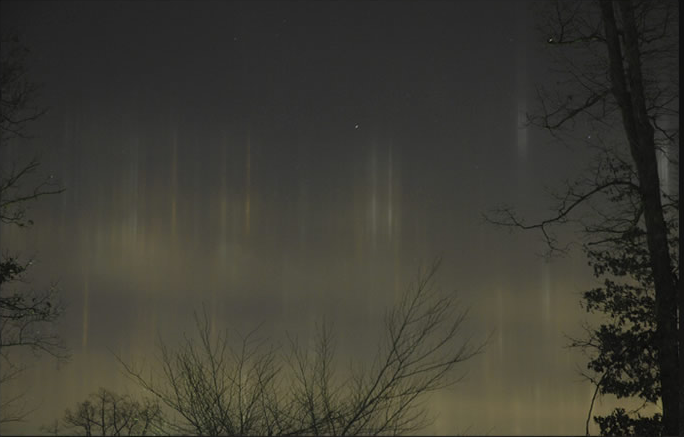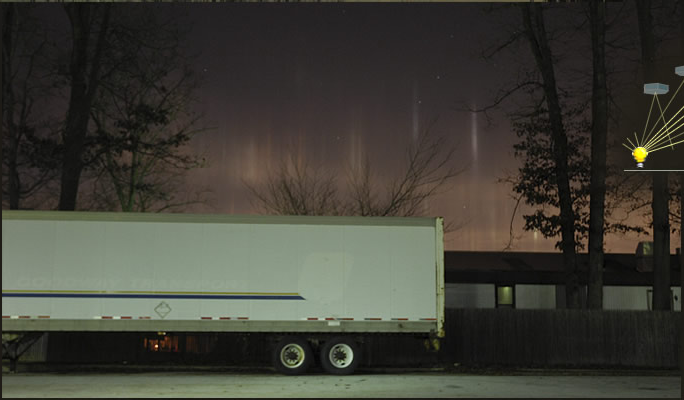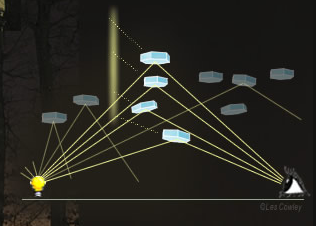Pennsylvania Lights
Pennsylvania Lights: Exploring the Phenomenon of Light Pillars
Have you ever gazed up at the night sky and witnessed a mesmerizing display of light pillars? These enchanting optical phenomena can often be observed in cold climates, such as in West Chester, Pennsylvania, where they create a spectacle that leaves onlookers in awe. In this article, we will delve into the fascinating world of light pillars, uncovering the science behind their formation and shedding light on their ethereal beauty.
Light pillars are a captivating sight that occurs when city lights are reflected by countless ice crystals suspended in the frigid atmosphere. These crystals, known as plate-like crystals, play a pivotal role in creating the pillar-like structures that grace the night sky. Contrary to what one might expect, these crystals are not neatly stacked directly above the lights but are positioned approximately halfway between the light source and the observer's eye. They possess a remarkable variability, ranging from near-perfect plates to larger formations that resemble delicate snowflakes.
One might wonder how these ethereal pillars come to be. The answer lies in the interplay between the light source, the ice crystals, and the observer's perspective. As the city lights illuminate the sky, the rays of light interact with the plate-like ice crystals, causing them to scatter and reflect in various directions. This scattering phenomenon results in the creation of vertical columns of light that extend upward into the atmosphere. The appearance of these pillars is reminiscent of flickering candles, adding an enchanting touch to the night sky.
It is important to note that light pillars, like other atmospheric halos, do not physically exist in any tangible space. Instead, they are optical illusions created by the interaction between light and ice crystals. The glimmers of light that compose these pillars are merely reflections directed towards the observer's eye, producing a stunning visual display that defies conventional spatial perception.
To witness the captivating dance of light pillars, specific atmospheric conditions must align. Typically, light pillars are observed in regions experiencing cold weather, where the temperature drops significantly below freezing point. In such conditions, ice crystals form in the air, serving as the canvas upon which these luminous pillars are painted. Additionally, clear to partly cloudy skies provide an ideal backdrop against which these optical phenomena can manifest their ethereal beauty.
The formation of light pillars is not limited to a specific location but can be observed in various parts of the world with the right atmospheric conditions. From the serene landscapes of West Chester, Pennsylvania, to the frosty realms of northern countries, these celestial spectacles can grace the night sky, captivating all who are fortunate enough to witness them.
In conclusion, light pillars are a captivating atmospheric optics phenomenon that delights and mystifies observers worldwide. The interplay between city lights, ice crystals, and the observer's perspective gives rise to these enchanting vertical columns of light. Whether they appear in West Chester, Pennsylvania, or other cold regions around the globe, light pillars serve as a reminder of the breathtaking wonders that nature bestows upon us. So, the next time you find yourself beneath a starry sky on a frosty night, keep your eyes peeled for these mesmerizing pillars of light that illuminate the heavens above.



Light Pillars over West Chester, Pennsylvania USA imaged by Rick Rotondo on November 19, '08. Images ©Rick Rotondo, shown with permission.
"It was 28.F when they appeared. They lasted for a couple hours, then dissipated. Very light snow flurry activity did occur intermittently.. .., otherwise it was clear to partly cloudy skies."
Light pillars are city lights reflected by millions of ice crystals in the cold skies. Plate-like crystals are responsible. Contrary to intuition, the crystals are not actually stacked over the lights but are instead roughly half way between them and your eye. They are very wobbly and range from near perfect plates to large habits approaching snowflakes. When they are in discrete layers the pillars take on the candle-like appearance here.
Like all halos, the pillars do not exist anywhere in real space. They are purely crystal glints that happen to be directed towards your eye.
Note: this article has been automatically converted from the old site and may not appear as intended. You can find the original article here.
Reference Atmospheric Optics
If you use any of the definitions, information, or data presented on Atmospheric Optics, please copy the link or reference below to properly credit us as the reference source. Thank you!
-
<a href="https://atoptics.co.uk/blog/pennsylvania-lights/">Pennsylvania Lights</a>
-
"Pennsylvania Lights". Atmospheric Optics. Accessed on November 26, 2024. https://atoptics.co.uk/blog/pennsylvania-lights/.
-
"Pennsylvania Lights". Atmospheric Optics, https://atoptics.co.uk/blog/pennsylvania-lights/. Accessed 26 November, 2024
-
Pennsylvania Lights. Atmospheric Optics. Retrieved from https://atoptics.co.uk/blog/pennsylvania-lights/.